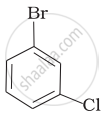Advertisements
Advertisements
Question
Arrange the following compounds in the increasing order of their densities.
(a)

(b)

(c)

(d)

Options
(a) < (b) < (c) < (d)
(a) < (c) < (d) < (b)
(d) < (c) < (b) < (a)
(b) < (d) < (c) < (a)
Solution
(a) < (b) < (c) < (d)
Explanation:
The density increases with increase in number of carbon atoms, halogen atoms and atomic masses of the halogen atoms bounded with the alkyl or aryl groups. Or, in other words density is related to molecular mass of the compound. Higher the molecular mass, greater will be the density of the compound.
APPEARS IN
RELATED QUESTIONS
Arrange the set of compounds in order of increasing boiling points.
Bromomethane, Bromoform, Chloromethane, Dibromomethane.
p-Dichlorobenzene has higher m.p. and lower solubility than those of o- and m-isomers. Discuss.
How many structural isomers are possible for a compound with the molecular formula C3H7Cl?
Which of the following is liquid at room temperature (b.p. is shown against it)?
Out of o-and p-dibromobenzene which one has higher melting point and why?
Which out of the following is an intensive property?
Why alkyl halides though polar are immiscible with water?
Why is the boiling point of o-dichlorobenzene higher than p-dichlorobenzene, but the melting point of para-isomer is higher than ortho-isomer?
Write the structure of the following organic halogen compound.
4-tert-Butyl-3-iodoheptane
Write the structure of the following organic halogen compound:
4-tert-Butyl-3-iodoheptane
